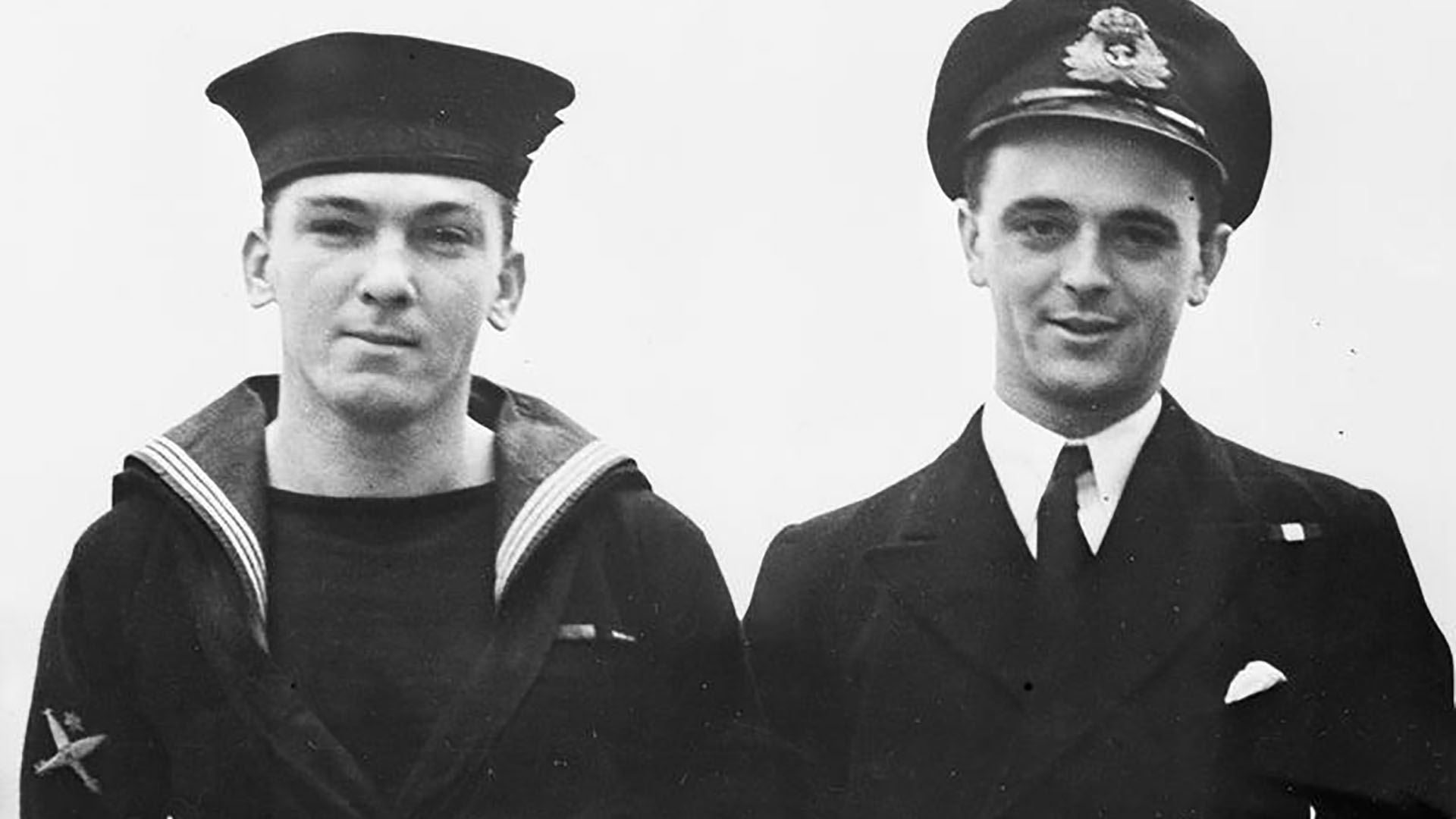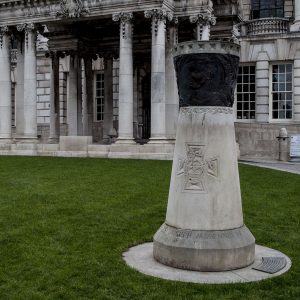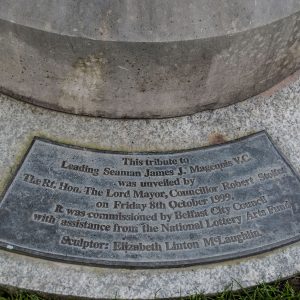Leading Seaman James Joseph Magennis (D/JX 144907) served in the Royal Navy during the Second World War. Born James Joseph McGinnes on 27th October 1919, he was the son of James McGinnes and Mary McGinnes of 4 Majorca Street, Belfast.
Until 3rd June 1935, McGinnes attended St. Finian’s Primary School, Falls Road, Belfast. Aged 15 years old, he then enlisted in the Royal Navy and served throughout the Second World War until 1949. On enlisting, he changed the spelling of his name to the more familiar Magennis. James served on several warships including the destroyer HMS Kandahar. Kandahar struck a mine off the coast of Tripoli, Libya in December 1941 causing irreparable damage. Magennis’ war continued as the Royal Navy scuttled the damaged destroyer the following day.
In December 1942, he joined the submarine branch. By March 1943, he had volunteered for “special and hazardous duties”. This meant training as a diver and operating X-Craft Midget Submarines. The first major use of these vessels took place in September 1943 when HMS X6 and HMS X7 attacked Tirpitz at Kafjord, Norway. For this attack, the Royal Navy mentioned Magennis in dispatches commending his “bravery and devotion to duty”.
He is the only recipient of the Victoria Cross from Northern Ireland for service during the 1939-1945 war. The Victoria Cross is the highest award for gallantry awarded to British and Commonwealth forces. Magennis’ commanding officer Lieutenant Ian Fraser also received the Victoria Cross at the same time.
Operation Struggle
On 31st July 1945, Magennis, onboard HMS XE3, took part in Operation Struggle, attacking 10,000-ton Japanese cruiser Takao. The Japanese warship operated as an anti-aircraft battery in the Straits of Johor, Singapore. Royal Navy submarine Stygian towed HMS XE3 into the attack area the previous night, the Midget Submarine slipping its tow at 2300hrs. HMS XE3 then travelled 40 miles through mines, wrecks, and Japanese listening posts arriving at Takao at 1300hrs on 31st July 1945.
Magennis in diving gear, left the X-Craft attaching limpet mines to the enemy cruiser. To add to the difficult operation, he had to spend 30 minutes removing barnacles from the vessel before attaching the explosives. He then returned to his craft, exhausted and with leaking breathing apparatus. On leaving the area of attack, Lieutenant Fraser noted one of the explosive carriers had not jettisoned. Magennis volunteered to leave the X-Craft again to dislodge the mechanism.
I’ll be all right as soon as I’ve got my wind, Sir.
For a further 7 minutes, James worked frantically with heavy tools to free the limpet carrier. He returned to the Midget Submarine once again and the 4-man crew made their escape to return to Stygian.
Victoria Cross
On 9th November 1945, The London Gazette carried the citation for Magennis’ Victoria Cross award. It read as follows.
Admiralty. Whitehall, 13th November 1945.
The King has been graciously pleased to approve the award of the Victoria Cross for valour to Temporary Acting Leading Seaman James Joseph Magennis D/JX 144907.
Leading Seaman Magennis served as a Diver in His Majesty’s Midget Submarine XE3 for her attack on 31 July 1945, on a Japanese cruiser of the Atago class. The diver’s hatch could not be fully opened because XE3 was tightly jammed under the target, and Magennis had to squeeze himself through the narrow space available.
He experienced great difficulty in placing his limpets on the bottom of the cruiser owing both to the foul state of the bottom and to the pronounced slope upon which the limpets would not hold. Before a limpet could be placed therefore Magennis had thoroughly to scrape the area clear of barnacles, and in order to secure the limpets, he had to tie them in pairs by a line passing under the cruiser keel.
This was very tiring work for a diver, and he was moreover handicapped by a steady leakage of oxygen which was ascending in bubbles to the surface. A lesser man would have been content to place a few limpets and then return to the craft. Magennis, however, persisted until he had placed his full outfit before returning to the craft in an exhausted condition. Shortly after withdrawing Lieutenant Fraser endeavoured to jettison his limpet carriers, but one of these would not release itself and fall clear of the craft. Despite his exhaustion, his oxygen leak and the fact that there was every probability of his being sighted, Magennis at once volunteered to leave the craft and free the carrier rather than allow a less experienced diver to undertake the job. After seven minutes of nerve-wracking work he succeeded in releasing the carrier. Magennis displayed very great courage and devotion to duty and complete disregard for his own safety.

Imperial War Museum Photo: A 26940A (Part of the Admiralty Official Collection). Temporary Acting Leading Seaman James Joseph Magennis of Belfast and Lieutenant Ian Edwards Fraser were both awarded the Victoria Cross for their roles in HMS XE3 during Operation Struggle in Singapore on 31st July 1945.
Life after the War
On his return from the Second World War, the citizens of Belfast established a “Shilling Fund” raising £3,600. Despite his almost celebrity status, authorities in Belfast refused to grant James Magennis Freedom of the City. Sources from the time suggest the Unionist dominated council did not think a working-class Catholic to be worthy of such an honour. A small photograph in the robing room of the Council Chamber was the only acknowledgment of James’ heroism.
In 1946, James Magennis married Edna Skidmore. The couple had 4 sons. The family quickly spent the money raised in the Shilling Fund.
We lived beyond our means because it seemed the right thing to do.
In 1949, James left the Royal Navy and returned to Belfast. After losing his job in 1952, he sold his Victoria Cross but an anonymous benefactor returned it under the condition it would not be sold again. In 1955, the family moved to Yorkshire and James found work as an electrician.
Remembering James Magennis
James Joseph Magennis died on 12th February 1986 aged 66 years old in Halifax, West Yorkshire, England. A memorial service took place in Bradford Cathedral, Yorkshire and the Royal Navy erected a memorial plaque. Cremation took place at Mab Wood Cemetery and Crematorium, Shipley, Yorkshire. There are several memorials to James Joseph Magennis in Northern Ireland.
On 8th October 1999, Belfast City Council erected a permanent bronze and stone memorial in the grounds of Belfast City Hall. This came after a long campaign by Magennis’ biographer George Fleming and Major S.H. Pollock. James’ son Paul Magennis attended the ceremony led by Lord Mayor of Belfast Bob Stoker.
Jim gave me bother from time to time. He liked his tot of rum, but he was a lovely man and a fine diver. I have never met a braver man. It was a privilege to know him and it’s wonderful to see Belfast honour him at last.
Lieutenant Ian Fraser, Belfast 1999.
His image adorns a gable wall mural in a housing development in Tullycarnet, Belfast. D.U.P. M.P. Peter Robinson unveiled the mural on 16th September 2005 to mark the 60th anniversary of Victory in Japan Day. There are 2 memorial plaques commemorating Magennis in his hometown. The first is at the Royal Naval Association, Great Victoria Street, Belfast, and a second at his former home at 32 Carncaver Road, Belfast. The Victoria Cross Medal awarded to James Joseph Magennis is on display in the Lord Ashworth Gallery, Imperial War Museum, London.




